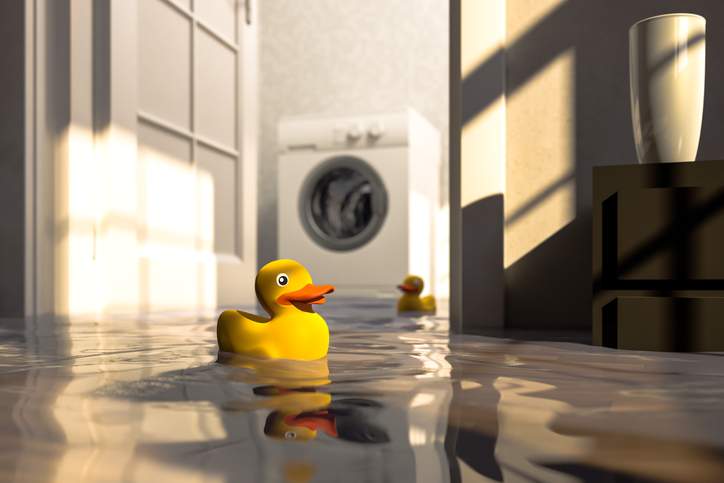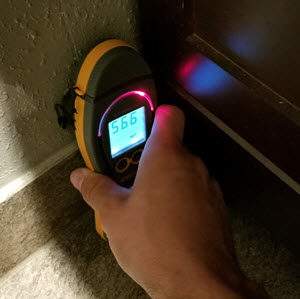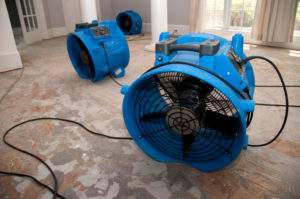The Steps of Drying Water Damage to Drywall

If you’ve experienced water damage to your home, it likely spreads further than the eye can see. You know that you need to dry out your possessions and carpet, but have you thought past these more obvious concerns, to where water may continue to lurk?
One particularly important area of concern is drywall. When drywall gets wet, it is an ideal breeding ground for bacteria and mold. Mold growth is linked to many health concerns, so if you have moisture in your drywall, it is essential that it be dealt with ASAP to stop mold growth before it starts.
Another reason drying drywall after water damage is essential is because damp drywall can compromise the structural integrity of your home. While drywall itself is not load bearing, if it is in poor condition, it can negatively impact the surrounding infrastructure, causing major problems and potentially creating an unsafe environment for you and your family.
According to HomeAdvisor, “drywall repair costs about $500 on average with a typical range of $250 to $750, but can cost much more or less depending on the destruction.” In any case, repair is cheaper than replacement, so if the water damage is brand new, it can save you money to repair right away, before the damage becomes more significant and replacement is warranted.
So, how do you go about drying out water damage? First thing’s first, this whole process will be easier in an empty room than a full one, so clear out the space. If any of your belongings have been damaged by water, handle those in a dry room. Once your room is empty, take the following steps.
Assess the Damage

Mold is one concern to think of straight away. If the drywall has been wet for more than 48 hours, mold may have already begun to grow. Unfortunately, if that is the case, while you will be able to dry things out, the drying process does not kill the mold spores. If too much time has elapsed, you should call in a professional water removal and mold remediation company.
Along the same lines, if too much time has passed, the structural integrity of your home may have been compromised. If the drywall has been soaked for days, it likely needs to be torn out and replaced, and you should call in professionals.
You also may not be able to safely do this job yourself is if the flooding came from above. You could be at risk of a ceiling collapse if you see water damage to the ceiling, so be careful.
One last consideration is the type of water you’re dealing with. If the water is clean and clear, like water from a burst pipe, you can handle it on your own. But if the damage was caused by grey or black water, it could contain toxic materials and isn’t safe for you to repair on your own.
Abbotts can provide you with a free consultation and estimate, so if there’s any chance that performing this work could endanger your wellbeing and that of your family, please reach out to make sure you’re good to go ahead on your own, or find out what professional repairs and remediation will run, if not.
Get a Moisture Meter

Thankfully, an incredibly helpful and inexpensive tool exists that allows you to determine what areas of drywall are wet, and their levels of moisture. A moisture meter is available at hardware stores, and runs around $40. A reading over 12% indicates wet drywall that needs to be dried.
Bring in Professional Equipment
Chances are, you don’t have large air movers and dehumidifiers sitting around. Hardware stores rent out this sort of equipment, so if you’re drying the moisture on your own, you’ll want to head to your local hardware store. Let them know what the situation is, and provide the measurements of the rooms and areas of drywall you’re needing to dry out, and they can provide the right tools and help explain how to dry out your water damage.
Prepare the Wall
To better dry the inside of the drywall and reach areas and materials that may get moldy if not dried out, you may want to prep your wall. Walls with insulation need to be prepped with flood cuts, while walls without need weep holes. Firewalls will require staggered cuts. These holes allow for draining, better air circulation, and faster drying.
You’ll also need to remove or pull back any flooring that may be wet, such as carpeting, baseboards, and trim.
Note that the material covering the wall matters. It will be harder to dry walls covered in high-gloss enamel, vinyl wallpaper, or more than one layer of wallboard. For walls with these coverings, you may want to consider enlisting professionals.
Get to Drying!

Seal the room up with plastic sheeting over windows and doorways. You might think opening windows will help, but it’s actually counterproductive. Work to get as tight a seal on the room as possible.
Get the air movers and dehumidifier going, and let them do their work. Regularly check the dehumidifier’s collection well, and reposition the air movers as necessary throughout the process to be sure to get everything. Use your moisture meter to track your progress.
It takes around 3-5 days to completely dry wet drywall, so patience is key, but you should be seeing consistent progress.
After It’s Dry
Check all over your wall with the moisture meter to make sure it’s completely dry. Don’t forget to check flooring, too — you want to make sure the room is totally dried out. If it is, go ahead and patch holes and repaint with an alcohol-based or oil-based paint.
Bring back in possessions once they’re dried out, if flooding occurred. If you’re concerned that mold has accumulated during this process, particularly if you’re experiencing any unusual health symptoms, please call in a mold remediation specialist to check things out. It’s always better safe than sorry when it comes to mold.
Abbotts is always here to help if the DIY process gets too intense and you need some help along the way.
Resources:
https://www.homeadvisor.com/cost/disaster-recovery/repair-water-damage/

